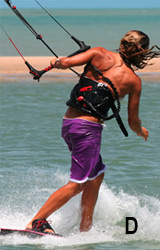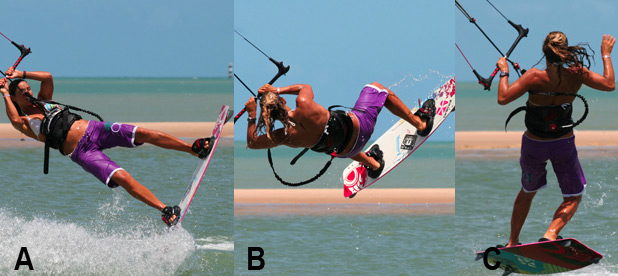Hooked in Back to Blind
Hooked in Back to Blind
Just like the hooked in front to blind, a nice solid pop to blind is expected of. It is recommended that you keep doing the pop even higher, wait longer before throwing the blind so you can really divide this movement from whatever still you want to execute.
The other thing you should concentrate is your trusty back loop. It will be worth your while doing slow controlled popped back loops to an uncontrolled blind. An over rotating spin will be much harder though. This signifies that your focus should be on your take-off, putting more power into popping as opposed to throwing your head around by spinning quickly.
Pic A – The surfer has just taken off, and the first thing to note is the position of the head. You should be looking at your arms and not over your shoulders. If you are ready to try this kind of move, you should be positive enough to perform a back loop around without even having to look for the landing. By looking straight ahead you will spin much slower than usual and it will be easier to stop the spin, plus you can turn other ways.
Pic B – Here, the surfer has almost finished the back loop and the board is almost 360 degrees around from the take-off downwind path. The aim here is to stop the rotation in preparation for the throw to blind. Also by pulling on the bar, you can keep powering the kite to drift downwind, which in turn will make landing a whole lot easier. You can see here that the surfer is still looking at its arms and is now ready to throw a blind.
Pic C – You can see here that the surfer keeps the bar in tight using the front hand. This stops the kite and leaves the bar behind to continue the pulling tension in the lines. To turn around, you need to let go your back hand and throw it around your back to have the rotation movement. Also, turn your head quickly to look back while pushing your front foot downwind and keep your rear foot tucked up underneath. This way the nose of the board will touch down first and goes for a clean reception. If you keep the front foot up, you will land flat on the board leading to a sudden stop and you’ll go down into the water.
 Pic D – Touching down. You can see that the surfer landed old nose first, which allows the board to pivot more downwind. Just keep your drive and look back with your weight over the old front foot. Even if you want to continue riding blind, you need to patch things up first before thinking of grabbing the bar for some movements.
Pic D – Touching down. You can see that the surfer landed old nose first, which allows the board to pivot more downwind. Just keep your drive and look back with your weight over the old front foot. Even if you want to continue riding blind, you need to patch things up first before thinking of grabbing the bar for some movements.
Sequences in Summary
1. The surfer has the kite just below 11 o’clock and has come in with enough speed to give momentum for the landing by taking off with the wind before carving up.
2. The surfer pops up off the water before turning far into the wind while keeping the head looking straight towards the arms.
3. As the surfer explodes up into a slow back loop, the surfer looks upwind and trusts the take-off to give enough rotation for the back loop.
4. As the rotation goes, the surfer pulls down with both hands towards the chest and brings the knees up and thus brings the board up towards the bar.
5. The surfer is nearly completing the back loop, pulling the hand and knees together.
6. With the board now coming forward and towards the kite, the surfer releases back hand and prepares to turn blind.
7. The surfer keeps back foot tucked up and turns head and shoulders powerfully against the back loop while keeping the bar pulled in and near.
8. The surfer lands on the old nose of the board, so it can turn to land flat and not on an edge. The surfer has all weight, knees, hips, shoulders and head committed over the old front foot.
Usual Problems
The only problem here is that every landing can be stopped if you do not have the drive going on. This technique needs sufficient speed when you take-off. Also, check your kite’s height so it doesn’t hurl up during the back loop because you will need it through the technique. Try giving a little tweak on your front hand just before releasing the back hand.
Important Keys
1. Speed off the wind
2. Pop early
3. Look through your arms
4. Tuck hard
5. Keep rear leg up
And here is what it should look like in reality:


Leave a Reply